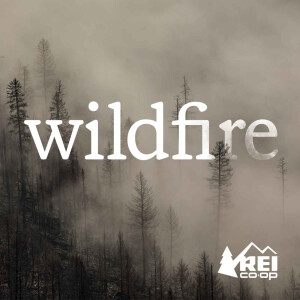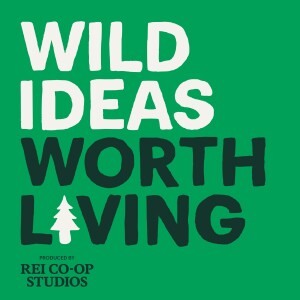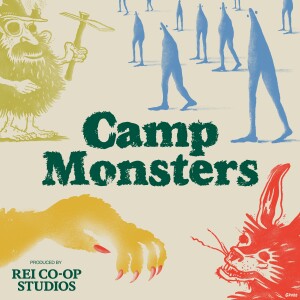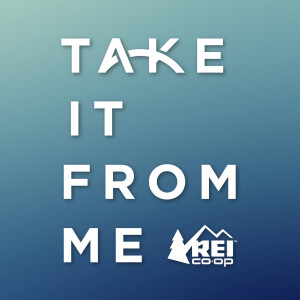

Episode List

Introducing Wildfire
Introducing Wildfire, a podcast presented by REI Co-op. This 6-part investigative series explores the past, present and future of wildfires by examining the devastating and controversial Eagle Creek Wildfire outside of Portland, Oregon. Hosts Graham Zimmerman and Jim Aikman, both Oregon residents, investigate the fire and what impacts it had, and continues to have, on the community as well as asking the question: what role do wildfires play in our lives?

Trapped by Fire
Show transcript On September 2, 2017, 150 hikers in Oregon’s Columbia River Gorge were suddenly and terrifyingly trapped near Punch Bowl Falls by the Eagle Creek Fire, a human-caused forest fire that burned for three months and decimated some 50,000 acres in one of the most unique, beloved and popular scenic areas of the Pacific Northwest. Episode one of Wildfire tells these hikers’ story and explores the broader issue of forest fires and their often misunderstood and contentious place in the natural order of our forests. Key takeaways: 1:01 – “The whole valley was on fire.” - A first-hand account of the Eagle Creek Fire 4:19 – Show Intro: The past, present and future of wildfire 10:45 – “More than just a place.” - The Columbia River Gorge 13:00 – The authorities learn of the Eagle Creek Fire 15:09 – Where we start with the story of wildfire: The forest 16:35 – Oregon’s forests, specifically those of the Columbia River Gorge 22:29 – Trapped by fire; 150 hikers behind a wall of fire 26:54 – “The real heart of the Gorge.” – What does this place mean to us? 41:55 – The point of conflict: The encroachment of modern civilization on wild space 43:27 – “I was one of the last people to see Tunnel Falls and The Punchbowl”- the escape 46:31 – Who started the fire? More About the Wildfire Podcast When a wildfire arrives at our doorstep, it’s a tragedy. This is especially true when these fires are human caused. But fire has always been an immense and immovable part of the natural order, particularly in the forests of the western United States. Forest fires and the destruction they cause are not black and white phenomenon, and they cannot be understood without looking closely at the issues that swirl and mutate around the subject of wildfire as much as the fires themselves. In Wildfire, hosts Graham Zimmerman and Jim Aikman explore the natural forest habitats in which wildfires burn, and how humans have historically interacted with forest fires and fire-susceptible terrain. Graham and Jim lead us into wild places impacted by forest fire; into history books; into conversations with scientists, naturalists, firefighters and politicians; and into the story of the destructive 2017 Eagle Creek Fire, a human-caused forest fire that forever changed Oregon’s Columbia River Gorge, one of the most unique and beloved scenic areas in the Pacific Northwest. Guided by the story of the Eagle Creek Fire—and the ordeal of the 150 hikers who were unexpectedly trapped behind its towering flames—Wildfire explores how, over the last 100 years in the United States, we have demonized and sought to suppress wildfire in an effort to preserve natural resources, scenic spaces, and, of course, human civilization. Connect with the hosts Graham's website and Instagram Jim's website and Instagram Evan's (aka: The audio wizard) website and Instagram Sean's (aka: The wordsmith) [website](Sean's (aka: the wordsmith) website) You can see more of Graham and Jim's work through their production company, Bedrock Film Works. Website Facebook Instagram

A Natural Phenomenon?
Are wildfires natural? And, if so, what purpose do they serve within the ecology of our forests? Has our recent history of suppressing and combating forest fires impacted the number and severity of wildland fires today? In this episode of Wildfire, hosts Graham Zimmerman and Jim Aikman explore the natural place of wildfire in our forests, and how our government’s recent approach to wildfire management has been drastically different from the approach of Native Americans, who, for thousands of years, struck a more harmonious chord with nature. They also continue the story of the human-caused Eagle Creek Fire, which, on September 4 and 5, 2017, exploded in size, threatening the small town of Cascade Locks, Oregon—"The Heart of the Columbia River Gorge”—with total devastation. Key takeaways: 1:00 – The Eagle Creek Fire threatens Cascade Locks - “Save the town, and the pizza is yours for free.” 3:55 – “The day after the fire started, all 150 hikers emerged, triumphantly, from the forest.” 4:35 – We learn the fire is human-caused - “When we finally heard about…who started the fire, there was a whole wave of emotions that came with that first understanding.” 7:01 – “Are wildfires a natural phenomenon? And is this phenomenon as much a part of the machinery of our planet as the changing tides and cyclical seasons?” 10:11 – The fire impacts Portland - “We came out to a car covered in what looked like a light dusting of snow, but was in fact fallen ash.” 11:24 – Tom Closter discusses the geography and geology of Mount Hood and the Cascade Mountain Range 16:19 – Wildfire in the Cascades - “Understanding that the Columbia is a dynamic area is to… understand that this is not a place that is a stranger to huge, violent and cataclysmic events.” 18:50 – “When is fire ok? When is fire a disaster? Living with fire…means thinking about how we as a society interact with these large, natural events that we now treat as disasters…” 20:56 – “If this is normal, how’re we meant to deal with it?” 22:30 – “Now, almost two years after the fire, is this something that we can—or should—consider a normal occurrence?” 26:08 – Native Americans and wildfire - “How did people live with this ‘natural’ phenomenon before we had all of this technology and manpower to suppress and manage it?” 33:30 – The future of fire management looks to the past - “For thousands of years, fire was a friend and a tool, and something that improved the land…” 43:59 – Dorian Soliz – Superintendent of The Warm Springs Agency Wildland Fire Module “Folks don’t understand that wildland fire is a very important part of land ecology.” 46:30 – “Native people have been doing this for generations. It’s not new to any of the tribes across North America.” 51:33 – “The law of the land for the U.S. Forest Service has been to suppress and combat fires. But what has that done to our nation’s forests? And could that have anything to do with the number and severity of wildfires popping up in the headlines every summer?” 52:01 – Back at Cascade Locks - “The fire was about to grow by 600 percent in about six hours, with no signs of stopping. It was clear that this situation was going to get much worse before it got any better.” 53:26 – “The fire exploded beyond any projections as the wind picked up and spread the flames west, toward Portland.” 53:40 – “There was nothing natural about the start of the fire at all, nor nothing like the prescribed burns of the native tribes. It was simply started by a teenager with a smoke bomb.” 55:51 – “What was under threat was our idea of the Gorge. This place that was once in our minds perfect, pristine and unsullied.”

Incident Command
After the 15-year-old threw a lit smoke bomb that caused the Eagle Creek Fire to erupt almost immediately during Oregon’s record dry summer of 2017, he and his friends fled downhill toward the trailhead. “Do you realize you’ve started a forest fire?”, demanded a hiker also attempting to escape the flames. “What’re we supposed to do about it now?”, the kids replied, clueless as to the severity of their actions. In episode three of Wildfire, we examine the incident command structure of wildland firefighting forces, how these response systems work, and what drives these men and women to keep going as they put their life on the line to stop these fires. We talk to a Fire Captain from Eastern Oregon, to one of the commanders from the Eagle Creek Fire itself, and to a wildland firefighter who worked in the early 2000s, the most-deadly era in wildland firefighting. And, of course, we hear from the people of the Columbia River Gorge about the initial days of the Eagle Creek Fire evacuation, when they were trying desperately to save their homes, their town and their lives. Key takeaways: 1:45 – One of the boys in the group pulled a smoke bomb out of his pocket... 4:58 – “I wanted immediate punishment. I was so livid.” 6:32 – “After the kid threw the smoke bomb into Eagle Creek, the following days unraveled into a gradually worsening nightmare.” 8:58 - On the fourth of September, the weather was dry and hot. The wind was gusting, and the fire in Eagle Creek was growing rapidly. 9:39 – “A huge feeling of helplessness. Even with all those firefighters, there was nothing we were going to do to stop it.” 10:10 – “How does all this wildland firefighting work?” A conversation with Kurt Solomon, captain of the City of Bend Fire and Rescue, and Division Supervisor of Northwest Team 8. 15:07 - “They just didn’t realize the severity of the wind in the Gorge.” The citizens of Dodson, Oregon feel the effects of the Eagle Creek Fire 17:24 – “Surely fire could not jump a mile of water…” The fire jumps the Columbia River. 18:47 – “Out of this unimaginable hardship, a spirit of resilience was brewing in Cascade Locks.” The community rallies to feed and support the firefighters 20:59 – “It’s hard to imagine a more harrowing job, outside of military service.” The life of a wildland firefighter 26:53 – “The thing that kills firefighters is not necessarily even the heat… You’re basically inside a tornado, a fire tornado.” 27:55 – “The proverbial cavalry had arrived.” The battle to save The Multnomah Lodge 33:28 – “The bond you create in the face of chaos” How do forest fires build camaraderie among wildfire fighting teams? 36:35 – “I didn’t know anything about PTSD…” The physical and emotional strain experienced by wildland firefighters 38:09 – “In the Columbia River Gorge, a sense of guarded optimism was settling in…” 41:46 – “The fire’s initial, explosive growth had slowed significantly…” Reflecting on the work of the fire professionals 44:05 – Is there a better way to “fight” fires? 44:54 – Back in the Gorge, the firefighters were working hard to use the opportunity afforded them by the calm winds. But the fire was only 7 percent contained. 46:40 – Who was the teenager who started it all? How was he being handled by the legal system during this emotionally-charged time? Resources: FEMA's Incident Command Resources Page Multnomah Falls Lodge More about the Wildfire podcast When a wildfire arrives at our doorstep, it’s a tragedy. This is especially true when these fires are human caused. But fire has always been an immense and immovable part of the natural order, particularly in the forests of the western United States. Forest fires and the destruction they cause are not black and white phenomenon, and they cannot be understood without looking closely at the issues that swirl and mutate around the subject of wildfire as much as the fires themselves. In Wildfire, hosts Graham Zimmerman and Jim Aikman explore the natural forest habitats in which wildfires burn, and how humans have historically interacted with forest fires and fire-susceptible terrain. Graham and Jim lead us into wild places impacted by forest fire; into history books; into conversations with scientists, naturalists, firefighters and politicians; and into the story of the destructive 2017 Eagle Creek Fire, a human-caused forest fire that forever changed Oregon’s Columbia River Gorge, one of the most unique and beloved scenic areas in the Pacific Northwest. Guided by the story of the Eagle Creek Fire—and the ordeal of the 150 hikers who were unexpectedly trapped behind its towering flames—Wildfire explores how, over the last 100 years in the United States, we have demonized and sought to suppress wildfire in an effort to preserve natural resources, scenic spaces, and, of course, human civilization. Connect with the team Graham's website and Instagram Jim's website and Instagram Evan's (aka: the audio wizard) website and Instagram Sean's (aka: the wordsmith) website You can see more of Graham and Jim's work through their production company, Bedrock Film Works. Website Facebook Instagram

A Retrospective
Only a few days after it started, the Eagle Creek Fire in the Columbia River Gorge was only seven percent contained, so a sudden increase in the wind could cause it to once again continue its approach toward Portland, Oregon, a heavily wooded city of 700,00 people that hadn’t seen any measurable precipitation in 50 days. Everyone was skeptical that anything but rain could put this fire out, and it was nowhere in the forecast. In episode four of Wildfire, we’ll look into our wildfire management strategy as an institution; to learn from its founding principles, as well as its pitfalls, and learn from our triumphs and mistakes to help chart the best path forward. How did these policies originate, and why? What lead to this overwhelming strategy of suppression, and where has that left us now? Regarding the young man who started the fire, we’ll reveal everything we know about him, from press releases and news articles, to hopefully make some sense of his crime. And from there, we’ll look at the birth of the National Forest Service in the beginning of the 20th Century, the pioneering efforts of Teddy Roosevelt and Gifford Pinchot, and the systemic perception of wildfire that has sunk its roots so deeply into society’s consciousness that it has been next to impossible to change. Key takeaways: 0:24 – The wind had finally died down, and for a moment, the fire had finally stopped spreading. 1:40 – The government elevated the fire from a type two incident to a type one incident. There were now more than 1,000 firefighters in the Gorge to fight this fire and stop it before it went nuclear… 6:55 –On September 2, 2017, a teenager in the Pacific Northwest walked into the woods and made a really, really big mistake. 8:45 – “Having a catastrophic event happen in the middle of a traditionally busy weekend obviously had an impact on every single business here in town. Our customers didn’t have a reason to come out anymore, because there weren’t any trails to run on, bike on, play on…” 12:15 – “From a developmental standpoint, working with teenagers, they’re with a group of friends, trying to look cool, trying to get that social acceptance, wanting people to think you’re a ‘badass’, and feeling like you’re invincible.” 15:27 – It simply isn’t true that this kind of fire will never happen again. These fires, manmade or not, will likely continue, as they have throughout history. 18:54 – “If you look back at the history of conflagrations in the United States, they pretty much align with the wave of frontier settlement....” – The history of wildland firefighting strategy, and the history if Smokey Bear 25:27 – It all fell apart in the 1980s, when full-suppression tactics came back into vogue. 29:00 – “We waged a war on wildfire as a nation. But is wildfire really terrible? Can we attach such a subjective and human label to something so far beyond us?” 31:49 – “Convincing the public that some wildfires are good is tricky, but convincing the government could be even harder. And wildfire management in the United States is inextricably attached to timber.” 32:35 – The logging industry grew by 1,000 percent at the end of the 20th century, and clearcutting went into full effect. You can’t drive through Oregon without seeing the scars of this unfortunate era. Every tree in America had a dollar sign on it. 34:27 – “We had a human-caused fire, an abandoned campfire, way up in a dead-end drainage, and the fire became very active and took off… and some individuals were trapped… and four perished, and two were badly burned. It’s not worth it, at all. It’s not worth a life.” 36:34 – “We need to learn to live worth fire, because it’s not going away.” 40:00 – “We’re never going to live in a world without fire, and we wouldn’t want to. But how would the legal system hold ‘The Kid’ accountable, and make a statement about his actions?” Resources Stephen Pyne's website Stephen Pyne's book: Fire in America The Big Burn by Tim Egan
You may also like
Create Your Podcast In Minutes
- Full-featured podcast site
- Unlimited storage and bandwidth
- Comprehensive podcast stats
- Distribute to Apple Podcasts, Spotify, and more
- Make money with your podcast





